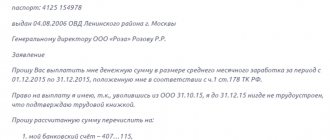How does the procedure for dismissing an employee take place and by what legal standards is it regulated?
It would seem that every working citizen knows the answer to this question.
But in reality, you can encounter nuances that will baffle even a legally literate person.
What does the law say about the need to work off upon dismissal? How is this period correctly calculated, and what days does it include? Is 2 weeks of work paid upon dismissal?
We will talk about this in detail in this article.
In what cases is an employee required to work 14 days after submitting an application?
The very concept of “dismissal” in the Legislation means the termination of an employment agreement between an employee and an employer, and the subsequent termination of their professional relationship.
The severance of this relationship can be made for three reasons:
- by agreement of both parties;
- at the initiative of the employer;
- at the initiative of the employee.
In the latter case, according to the law, the employee is registered with the company for another two weeks from the date of filing the application.
This period is given to the employer in order to replace the employee. If he does not have time to find a new person for the vacant position, he still does not have the right to retain the employee in the company.
How long must an employee work?
The deadlines for notifying the employer of your resignation, or the duration of work, are indicated in the Labor Code of the Russian Federation:
- 14 days is the standard period used in most cases (Article 80 of the Labor Code).
- 3 days - while on probation (Article 71 of the Labor Code).
- 3 days - for seasonal employment (Article 296 of the Labor Code).
- 3 days - when concluding a contract for a period of no more than 2 months (Article 292 of the Labor Code).
- 1 month - for the head of the enterprise (Article 280 of the Labor Code).
- 1 month - for coaching staff, athletes with a contract period of more than 4 months. In this case, it is possible to increase the period in the employment contract (Article 348.12).
During the working period, weekends, holidays, vacation and sick leave are counted.
The period may be reduced or canceled by agreement with management or for compelling reasons. In the absence of grounds, work is carried out, despite the period of professional activity at this enterprise.
For example, if an employee decides to quit a month after concluding a standard employment contract, he is obliged to notify management 2 weeks in advance and continue working until the end of this period. If he was on probation, his work would be reduced to 3 days .
How does the dismissal procedure, which requires a mandatory two-week period of service, take place?
Sample application for voluntary resignation
Having decided to leave his position, the employee must submit a corresponding application to the employer. Despite the fact that in principle there is no statutory template for such a statement, the document must still include certain mandatory clauses.
The first and basic rule is that it must be in writing. Simply coming to the HR department and resigning by submitting a verbal application will not work.
The application must also contain the following mandatory items:
- date of document preparation;
- day of dismissal (indicated by the employee);
- personal signature of the employee;
- basis for filing an application: in this column it is simply written “at one’s own request.”
According to the law, the employee is not required to describe the reason for leaving his position in detail. You can submit your application personally to your manager, write it to the HR department, or send it by mail with notification.
When the obligation is removed
It is permissible not to fulfill the obligation to notify the employer upon dismissal at one’s own request when the following circumstances are present:
- start date;
- joining the army;
- loss of ability to work;
- retirement;
- moving to another city;
- decree;
- other situations that do not allow you to continue working.
This is also important to know:
How to correct an invalid entry in a work record: a sample of making changes
Separately, the legislator identifies other circumstances that allow you to quit without working off. They are associated with violations of norms:
- non-payment or delay in payment of wages;
- denial of legal leave;
Such violations must be documented by authorized authorities:
- Labour Inspectorate;
- prosecutor's office;
- court.
In all of the above cases, the employee is fired on the day indicated by the application, without working off.
Norms of legal regulation of relations between employee and employer
The issue of the procedure for dismissal and the need for service, as well as its specific terms, is discussed in Article 80 of the Labor Code of the Russian Federation.
According to it, a period of two weeks for working out is designated as the “warning period for leaving a position.”
As such, the employee does not need to go to work on these days, and the law does not provide for it.
Having decided to quit, he can spend all these two weeks on unpaid leave without pay or on sick leave. The employer is obliged to find a replacement for him during this time.
If an employee to fill a vacant position was found earlier, the previous one, by agreement with the employer, will not have to fully work out this period. The main condition is that a new specialist must be invited to work for the company officially, in writing.
After the two-week notice period has expired, the employee has the right to stop working. After this period, the employer must pay the employee in full by issuing the original Work Book with a record of dismissal. The date of the employee’s actual departure from the company and the date of dismissal from the Labor Committee must coincide.
Example. The employee wrote a letter of resignation on December 3, 2015. This application was registered in the personnel service on December 3, 2015. The deadline will be counted from the day following the day the employer receives the original application. That is, from December 4, 2015. The end of the warning period in this case will be December 17, 2015. On this day, the final payment is made to the employee and all necessary documents are issued to him.
How to quit your job: actions
If you need to leave your job on your own initiative, the dismissal procedure consists of the following steps:
- Writing and submitting an application to the manager. This document should indicate the date of the application and the reason for dismissal. You can simply write “at your own request.” It is also possible to indicate a specific reason, for example, “due to relocation.” This may serve as a reason for the employer to agree to cancel the work.
- Work within 14 calendar days. The work period begins the next day after submission of the application. Moreover, if the employer does not sign the application, the work will nevertheless be counted from this day, because the application indicates a specific date.
- Order of dismissal. This act is drawn up and signed by the manager. The date of the order may coincide with the date of the employee’s last working day. In this case, it is allowed to be published before the end of the service, but indicating the date of dismissal, coinciding with the last working day. The dismissed person must be familiarized with the order against signature.
- Filling out personnel documents. This responsibility lies with the company's HR department. A record of the employee’s dismissal from his position is entered in the work book. This is done on the last day, due to the fact that during the working period a person may change his mind about quitting.
- Receiving documents and invoices. According to part four of Article 84.1, the management of the organization is obliged to fully pay wages and other payments on the last working day. Also on this day, a work book and, if necessary, certified copies of work-related documents are issued.
This is also important to know:
Reasons for leaving a job: grounds for terminating an employment contract
A mandatory entry in the work book about voluntary dismissal is reflected as follows:
What day does the work start?
As mentioned above, working out the two-week period begins the day after the employer accepts the resignation letter.
It must be officially registered with the HR department.
If the application is submitted and registered on the same day - say, June 5 - then work begins on June 6 and ends on June 20.
If the application was sent by mail (for example) on June 5 and it was registered in the personnel department on June 12, then the countdown begins on June 18.
Cases when you do not need to work 2 weeks and who may not work them
Just as any rule has exceptions, there are also those who may not work upon dismissal. So, you can quit without having to work for a period of two weeks in the following cases:
- If there is an agreement between the parties on this issue . For example, a person who is planning to resign from a company has a good relationship with his employer, and he may well let him go without working the required period. Either the employer simply has no desire to keep him, or there is already a candidate for this position.
- Enrollment in an educational institution. If an employee has entered a college, institute or university, then he can quit without any problems and the director, in turn, is obliged to terminate his employment relationship on the day the former worker of the enterprise wrote a statement. But still, in this case, warn about your dismissal in advance.
- Retirement. Pensioners also do not need to work off, since they are not required to work at retirement age.
- Moving and a new place of residence or sending a spouse to a new location or abroad.
- Moving to a new place, if it is impossible to live in the previous one, due to health problems (must be confirmed with a medical certificate).
- Inability to do your job due to health problems.
- Caring for a child who has not yet reached 14 years of age or caring for a disabled child, it can also be caring for a sick relative or a disabled person of the 1st group.
- pregnant women or those raising 3 or more children under 16 years of age.
Summarizing all of the above, I would like to note once again the date from which the working period for dismissal is set - the countdown starts from the next day after the employer receives the employee’s statement of desire to resign. On the last day of the working day, the boss must pay you off and give you your work book.
ipinform.ru
Taking into account weekends and holidays when calculating the working period
A fairly pressing issue is the system for accounting for weekends and holidays when calculating working hours.
The law does not say that these days are not taken into account in the required two-week period.
And according to the law, the employer has no right to demand that an employee work extra days, citing holidays or weekends.
The Law states that the period of service is calculated in calendar days. But there is also a point that confuses many employees. It states that if the last day of the calendar period falls on a non-working day, then dismissal occurs on the next working day after the expiration of this period.
This point should be taken literally. If an employee submitted a letter of resignation on December 19, and it was registered in the personnel department on December 20, the last day of the work period becomes January 3 of the next year. The days from January 1 to January 6 are considered holidays, that is, the employee will be fired on January 7.
The employer does not have the right to require an employee to work extra days, citing holidays or weekends.
Does vacation count?
To calculate the correspondence between vacation days and the period for working, you need to find out what period the worker is supposed to rest. This is done by the HR department.
The following is taken into account:
- Number of months worked. In this case, an incomplete month is not used in calculations. The exception applies to a period greater than half. In this case, a full month can be considered in favor of the employee.
- Number of working days in a month.
Important! If there is an unused vacation period, it is also taken into account (added).
To get the number of days you need to do:
- dividing the number of days for the year by 12;
- multiplying the resulting value by the number of months worked.
If the standard period for vacation is 28 days, then, as a rule, there are 2.33 days of vacation. Everything is rounded up in favor of the employee according to Letter of the Ministry of Health and Social Development No. 4334-17 dated December 17, 2005.
They can calculate the specified period with the calculation to cover the necessary work if the application is written for leave with subsequent care:
- That is, instead of working in accordance with 2 weeks of work, the employee can use rest and leave earlier.
- In this case, the employer has the right to count vacation as working time, but is not obliged to do so. Since the activities of a resigning employee may be associated with various features that require the search for a replacement and other factors, the employer has the right to refuse by offering compensation.
These reasons include:
- Taking vacation ahead of schedule.
- The employee wanted to use the right to extraordinary rest.
- Vacation has already been used.
If the leave is within the approved schedule, they have no right to refuse it. In the event that the request is rejected to take into account the vacation, there is the option of using social holidays. Such leave without pay can be counted as working time.
If leave is required for personal reasons, it is granted in the following situations:
- if the employee took part in the Second World War (period up to 35 days according to the calendar);
- if you want to work while retired (the right to 14 days, which corresponds to the time you worked);
- the closest relatives of government employees who died as a result of their official duties - 14 days;
- disabled people who are entitled to up to 2 months of rest per year;
- for family reasons due to the birth of a child, marriage registration, death of relatives - up to 5 calendar days.
Sick leave during the period of service
If during the period allotted for working off, an employee falls ill, this does not affect the extension of this period in any way.
According to the law, the employer must formalize the dismissal and effect it on the day the work period expires, regardless of the fact that he is on sick leave.
He is obliged to pay the employee in full.
Upon expiration of the temporary disability period, the employee must contact the organization and present a sick leave certificate. He will have to be given the necessary documents and make all required payments.
The Law also provides for a resigned person to apply for compensation for sick leave to the organization from which he was dismissed after 30 days from the date of dismissal.
The former employer will be obliged to compensate him for sick leave in the amount of 60% of its usual amount. True, this rule is valid only if within a given thirty-day period the employee was not officially enrolled in the staff of another company. This item is regulated by Federal Law No. 255.











